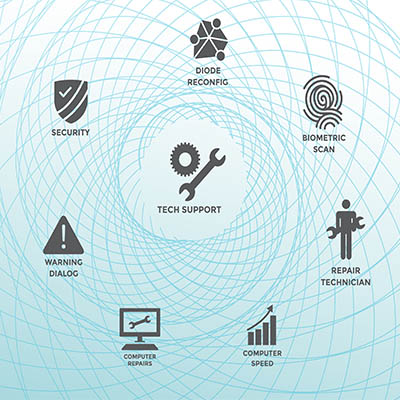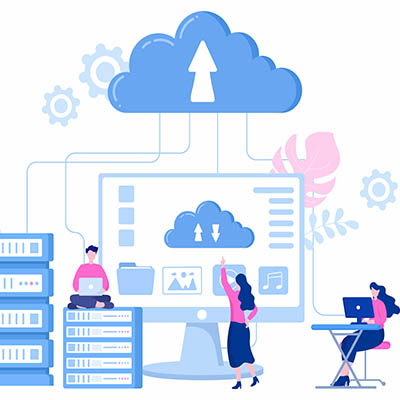It was only a few decades ago that purchasing a couple of computers for a business was almost the same investment as purchasing a decent company van. In 1986, a business could spend $3500 on a single Compaq Portable II, which was a 24 lb monstrosity with a tiny 9-inch screen. Alternatively, a Chevy Astro Cargo Van cost about $7800 around the same year.
I like making the van comparison because it’s a very easy frame of reference for the cost of starting a business. Starting a business is a pretty significant investment, and more than once I’ve made the comparison to new entrepreneurs that even a very small, basic tradesperson needs to at least invest in a service van. In other words, you need to just accept that there’s going to be some base-level cost in order to be professional.
So let’s get back to the 1980s, when the computers were hot, huge, and expensive. For younger readers who were born well after the 80s, it also helps put things in perspective to admit that computers back then were extremely limited in capability. They could store data, sort data, let you manage spreadsheets, and maybe print out a report. There was no Internet, at least, not really, and email wasn’t really all that widely accepted until much later on in the decade.
So why did businesses shell out thousands and thousands of dollars for these extremely expensive computers?
Despite the expense, despite the extreme novelty, and despite the lack of modern capabilities, computers revolutionized the way we all did business. Businesses that adopted technology saved money, and were able to collect more information and process that information in new and better ways. A store inventory could be managed without manually counting products, a manufacturer could track specific metrics about the entire assembly line, and a business could streamline literally everything around their accounts and expenses.
Technology = Value
In a world where it certainly feels like Apple and Samsung really want you to buy a new phone every year, and technology has become such a big part of life that we use terms like “off the grid” and “unplugged” as a way of giving ourselves a break from it all, it’s easy to forget why we invested in all of this glass, plastic, aluminum, and copper in the first place.
It’s so easy to feel burnout, partially thanks to how fast things change, how complicated technology has gotten, and how people are constantly trying to exploit modern technology to get in your face, steal your data, or just plain overcomplicate things.
For this thought experiment, I want you to imagine what your organization would look like if there weren’t computers, laptops, tablets, or smartphones.
How would a typical day go?
How would everyday tasks get done?
You’d have to start recording all information into paper ledgers—who is handling that? Who’s responsible for accuracy and redundancy? How are you communicating with customers and clients?
Everything suddenly gets a whole lot harder, and depending on your managerial style, you are either going to start sending everyone home or require some lengthy overtime.
You’ve Invested a Lot of Time and Money Into Your IT Already
None of this stuff is cheap. Sure, desktops and laptops have gone down in price for the most part over the last 20 years, and most hardware does tend to last a lot longer than it used to, but your IT and your overall network was not cheap. You sunk serious money into purchasing hardware, training your staff over the years, paying for software, and scaling it around your business.
Over the next few years, you are likely going to continue to invest in your IT. I’m not just talking about replacing older computers or upgrading your 10-year-old server. Your industry, no matter what it is, is going to change by adopting some new technology.
If you deal with money or sensitive information, you’ll need to meet specific compliance standards to protect your customers and their information. Insurance companies are likely going to start investing in blockchain technologies to securely handle claims. Manufacturers continue to adopt Internet of Things technology to streamline and automate reporting.
Adopting new technologies means a better end result, less error, and more customer satisfaction. It means shorter turnaround times, real-time analytics, and fewer steps in a process that a human could mess up.
Businesses that see the value in technology and carefully plan out their IT to grow into these new technologies will gradually outperform and outcompete businesses that don’t. It’s that simple.
Start Looking at Technology as a Profit Center, Not an Expense
Businesses in the 80’s invested in giant 24 lb “portable” computers because they knew the investment would eventually pay for itself in value. It’s time to start looking at your IT like that again.
No, I’m not saying you should go out and buy fully-loaded $5000 Alienware Aurora gaming PCs for each and every one of your staff, but you should definitely be looking at your budget and looking into ways that you can optimize and automate your business.
If you or your staff are dealing with snags that waste a lot of time, or have pain points involving technology, it’s time to get them completely ironed out. It’s time to take a good look at business continuity and deeper cybersecurity so that you don’t ever have to feel cursed simply by being connected to the Internet. An ounce of prevention is worth a pound of cure when it comes to this sort of thing.
That’s the big difference. A business that sees their IT as a way to automate, sustain, and actually drive business forward is typically going to make intelligent decisions when investing in it. That includes understanding the additional investment in managing your technology and supporting your users.
That’s where we come in.
We’re not really here to sell you new hardware. Sure, we can do that, but our goal is to bring everything together for you. We can act as your virtual CIO and help you make informed decisions about driving your business forward with technology. We can manage and monitor and maintain your IT and provide support for your staff the same way an internal IT department can (but without the expense of training, certifications, and staffing).
If you value technology, we’re the perfect fit for you. Want to learn more? Give us a call today at 978-798-6805.







